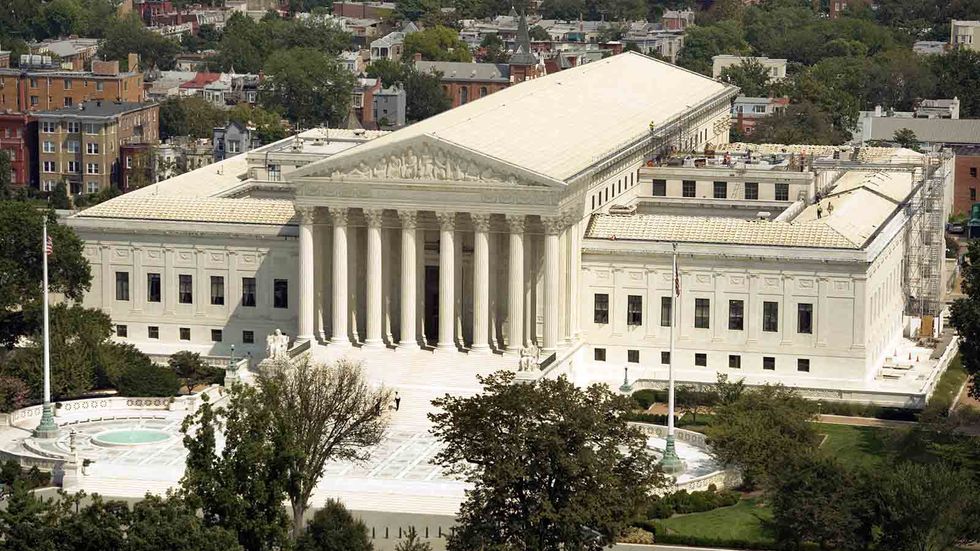
© 2024 Blaze Media LLC. All rights reserved.
Earlier today, the Supreme Court heard oral arguments in the Virginia redistricting case on appeal from a lower court decision to completely redraw the map in the middle of an election. Once again, the most important political questions of our time are all decided by the unelected branch of government – the one that was to have “neither force nor will.”
The practice of gerrymandering, drawing congressional district boundaries to benefit those in power, is as old as it is unfair. After all, this odious practice was named after one of its earliest practitioners, Elbridge Gerry, one of the top Founders and the fifth vice president of the United States. However, what is a new and even more pernicious practice is the federal court system disenfranchising the voters and redrawing congressional districts in the ultimate act of legislating from the bench.
After every decennial redrawing of the maps, a number of states run by either party tend to get carried away with their power to draw the boundaries and create districts that fail to respect the geographical, demographic, or cultural integrity of the region. The reality is that both parties engage in gerrymandering. Yes, it is unfair. But what should be the remedy? Using the electoral process to punish these trouble makers or having the unelected judges redraw even worse maps?
We are witnessing a pattern across the country ever since the districts were redrawn from the past Census and reapportionment. Democrat gerrymandering in blue states is consistently upheld, GOP redistricting is struck down by the courts, and the courts proceed to rashly redraw those districts, engendering an even worse outcome of disenfranchisement. While gerrymandering disenfranchises voters, having the courts redraw districts in the middle of an election is even worse because they do so arbitrarily, they tend to favor Democrats (surprise, surprise), their decisions are not uniform across the nation, and there is no recourse for the voters.
North Carolina
In the most egregious case of judicial activism, a three-judge federal district panel ruled on February 5 that North Carolina’s 1st and 12th districts were created based on race and mandated the redrawing of the state’s congressional map. This, after the map was upheld by the state’s supreme court. As such, they tossed out the entire map and forced the legislature to redraw the districts after voting in the March 15 primary had already begun. So much for John Marshall’s promise to George Mason at the Virginia Convention that “there is no danger, that particular subjects, small in proportion,” being given over to the federal courts “will render them [state courts] useless and of no effect.”
Now that the primary has been pushed off until June 7, all those absentee ballots have been thrown in the garbage, yet many voters are probably unaware of the fact that they need to vote again. Moreover, candidates who spent thousands of dollars and countless hours canvassing voters in one district are completely shut out of this election. All the hard work of those challenging Rep. Renee Ellmers in the primary for district 1 has been for naught.
Even if the North Carolina map was originally drawn in an unfair manner, having the courts toss out a map in middle of the election is egregious. While North Carolina is the worst example, given the proximity of the decision to the timing of the election, the Virginia case is almost as bad. We’ve witnessed a similar dynamic in Florida. In all these states, courts tossed out Republican-drawn maps because they felt the boundaries were drawn based too much on racial factors.
The Hypocrisy on Racial Gerrymandering
The twisted irony here is that it is Democrats who are factoring in race when they gerrymander in blue states; Republicans are, for the most part, respecting the natural boundaries (although not in North Carolina). Take Maryland for example. While the courts are tossing out one Republican-drawn map after another, the Maryland map, which is the most gerrymandered in the nation and is all about racial politics, is still standing after the first round of litigation through the court system.
Take a look at my home district, the 3rd district, which is possibly the most gerrymandered district in the country. A federal judge called it a “broken-winged pterodactyl, lying prostrate across the center of the state.” The city of Baltimore has a population of 621,000, easily within the confines of the roughly 721,000 limit for a congressional district. Under any pretense of fairness, the city should have its own congressional district. Yet, as you can see, Democrats divided it up into three separate districts.
Thus, while voters and candidates in North Carolina, and now possibly Virginia, have been disenfranchised in middle of an election, wasting two years of hard work on the part of insurgency candidates, Maryland Democrats have gotten away with this travesty. This is what happens when the courts become the final arbiter of election maps.
It’s also no secret that the courts side with the Democrats in believing that the black vote should be spread out rather than confined to its geographical jurisdiction. After all, this is not about ensuring blacks have equal representation; it’s about ensuring Democrats can maximize the map.
With exceptions in certain parts of the country, such as New England, the base of Democrat support is anchored in very strong support from minorities, most prominently African-Americans. These voters are largely clustered in small geographical areas, primarily in large cities. The historically high turnout from minorities was enough to push Obama over the top where electors are awarded in a winner-take-all basis statewide. But his dismal showing with white voters and non-urban areas cost Democrats heavily in congressional elections, which are localized to specific districts. Democrats want more urban areas to be apportioned like the Baltimore area. The courts agree with them.
This is why a three-panel district court tossed out Virginia’s map in the case pending before the Supreme Court today. They feel that the third district incorporates too many black voters, preventing Democrats from splitting up the black vote into two winnable districts. But take a look at the map and decide for yourself whether anything looks contorted or unfair. This map actually looks quite reasonable. The city of Richmond is not large enough to constitute its own district and must incorporate more counties in order to fill its population mandate based on reapportionment. Republicans simply choose to make the district lean southeast and incorporate more black counties. Had Democrats controlled the process at the time of redistricting, they would have drawn it differently. Either way, this is a reasonable and contiguous map, so why is it that Maryland’s third district is just fine while Virginia’s third district is problematic?
It’s quite evident that not only are the courts the final word on all political questions, they always decide them in favor of the Democrats. They have it exactly backwards. Article I, Section 4, Clause 1 of the Constitution explicitly grants state legislatures the authority to prescribe the manner and place of holding elections. Only the legislative branch of the federal government, not the courts, were given authority to “alter such regulations” of the states on electoral decisions, and even then, according to Hamilton it was only to be done under “extraordinary circumstances.”
We have now come to the point when the unelected branch of the federal government determines the outcome of every important societal question left up to the states, including life, marriage, prayer, and now elections themselves. As I warn in my upcoming book, if Congress fails to reclaim this power from the courts, using its Article III, Section II power to regulate the court’s jurisdiction, we will no longer have a functioning democracy.
Thomas Jefferson warned this day would come:
[T]he germ of dissolution of our federal government is in the constitution of the federal judiciary; an irresponsible body, (for impeachment is scarcely a scare-crow,) working like gravity by night and by day, gaining a little today and a little tomorrow, and advancing its noiseless step like a thief, over the field of jurisdiction, until all shall be usurped from the States, and the government of all be consolidated into one.
Indeed, the legislative branch of government has its own share of problems. But the minute we vest the power to legislate with the unelected branch of government, we cease to function as a democratic Republic.
This is the point Republicans must remind the media of as the fight over Merrick Garland reaches its crescendo. If the courts are now the final arbiters of all political issues, including elections, then shouldn’t we need an election to determine the balance of the court?
Want to leave a tip?
We answer to you. Help keep our content free of advertisers and big tech censorship by leaving a tip today.
Want to join the conversation?
Already a subscriber?
Blaze Podcast Host
Daniel Horowitz is the host of “Conservative Review with Daniel Horowitz” and a senior editor for Blaze News.
RMConservative
more stories
Sign up for the Blaze newsletter
By signing up, you agree to our Privacy Policy and Terms of Use, and agree to receive content that may sometimes include advertisements. You may opt out at any time.
© 2024 Blaze Media LLC. All rights reserved.
Get the stories that matter most delivered directly to your inbox.
By signing up, you agree to our Privacy Policy and Terms of Use, and agree to receive content that may sometimes include advertisements. You may opt out at any time.






